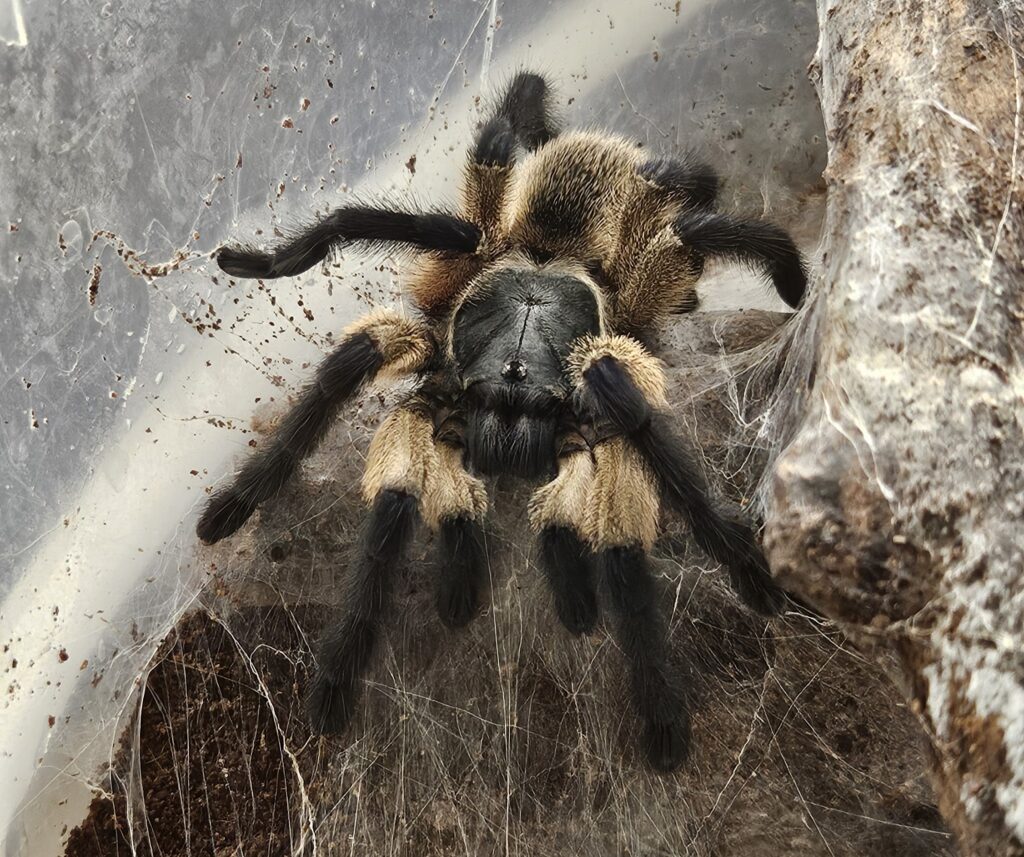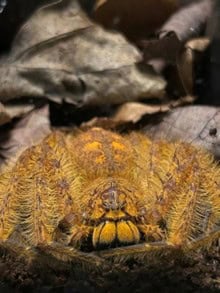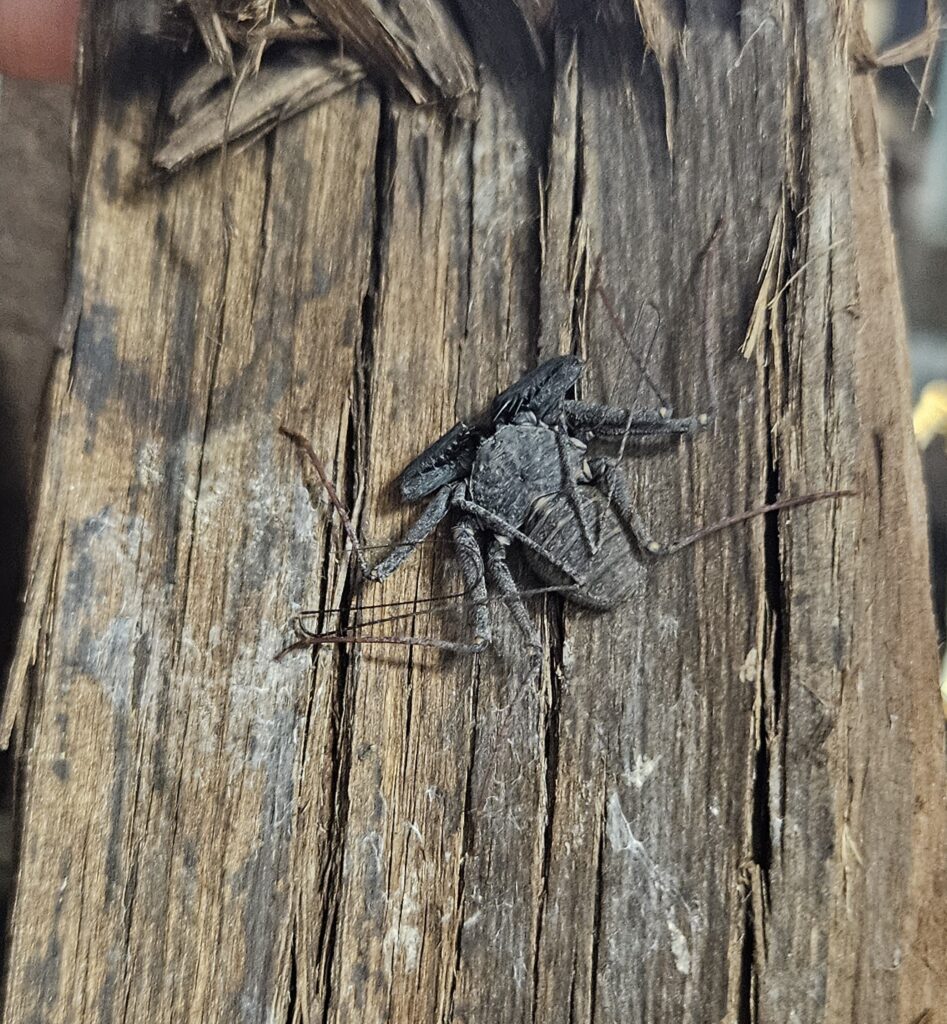Hi everyone, I’m Beth the Deputy Head of Reptiles and Invertebrates here at Wingham Wildlife Park! I thought there would be no better way to start my first blog here than to introduce you to some of my favourite invertebrates living here at Wingham on my bug list.
Part 1: Arachnids
Warning! If you fear tarantulas and all things creepy crawly then this may not be the blog for you. Please try and keep reading as I believe I can convince you that these spiders are cutie pies. They would only ever harm a fly, locust, and maybe a very small mammal or amphibian. Creepy crawlies are both adorable and interesting! Now, in no particular order, let’s meet some spiders!
1. Petunia
Petunia is our resident female salmon pink bird eating tarantula. This species is the 4th largest species of tarantula in the world! She is the sweetest and calmest of our tarantulas; she rarely reacts to movement, and you can put your hands in and around the enclosure with no fear of being bitten. In the mornings, she often sits on the log near her water dish waiting to greet us. The only time we ever get any reaction from her is when we accidentally spray her misting her enclosure. As tarantula hairs are very sensitive, this often causes her to have a little stomp and sulk before she calms down.
Although this species has an extremely mild venom (for humans, it is less potent than a bee sting), it does not make her any less of a successful predator. With a fang length of around 6cm (2.5 inches) salmon pinks can take down a variety of sizes of prey, from crickets to small amphibians and mammals. She attacks the prey by grabbing them with her front legs and inserting her fangs into their body. She will then inject her very weak paralysing venom into the prey before injecting a digesting enzyme. This digests the tissues for her, allowing her to use a suction like motion to suck up the nutrients she needs.

2. Penelope
Next on my bug list is another tarantula. Penelope is an adult female Monocentropus Balfouri, commonly called the Socotra Island blue baboon tarantula. This species is found on a group of islands off the coast of Africa, where Socotra Island is the largest, hence the common name!
This beautiful species is famous for its beige body, dark blue legs and a leg span of about 16cm (females)! Luckily for us, the females live 15 years on average, so we have many years left with this feisty lady.
Unlike Petunia, Penelope is a feisty tarantula! She makes the day more interesting when she tries attacking the tongs, water, air, and water dish in the mornings; only if she decides to leave her burrow.
If you visited the bug room last year, you may have seen the young spiderlings that were happily living with Penelope until recently as she laid us a surprise egg sack in 2023. We still have three of these youngsters living off display and are now halfway to being fully grown themselves!

3. Ziggy
“Up until one century ago there lived,
In the Zi Duang province of eastern country
A glass-like spider
Having devoured its prey it would drape the skeletons over its web”
-David Bowie Glass Spider
Next on my bug list is Ziggy Stardust the Heteropoda davidbowie, commonly known as the David Bowie Huntsman spider. This species of huntsman spider is commonly found in Malaysia. They were named in honour of the singer David Bowie due to its bright orange/blonde colouration!
Like most typical Huntsman spiders, Ziggy is very, very quick. A catch cup is always on hand when going into his enclosure as the slightest movement could cause him to run around and out of the tank! You are most likely to see him lying on the bark or leaflitter in the tank. This is because his colouration acts as the perfect camouflage to protect him from potential predators.

4. Wednesday
One of the most critically endangered invertebrates that we have in the bug room is Wednesday our Gooty ornamental tarantula. Originating from deciduous forests in Southern India, this tarantula faces threats from specimen collectors for the pet trade and the degradation of their natural habitat due to logging and firewood harvesting.
Although currently off display, Wednesday and her Ex-boyfriend Gomez used to be on display so some of you who have visited the zoo over the last two years may have seen them. Wednesday is an unusual tarantula due to her colouration. Although the image below doesn’t show it very well, she is a bright purple/blue with yellow banding on her legs and bright white patches all over her body making her very pretty to look at. As a species, Gooty Ornamentals average out with a 20cm leg span, so they are big, beautiful, blue, beasties!

5. Winifred
Winifred is a Florida tailless whip spider that is about 5cm long. When visiting the park, you may find it hard to spot Winifred as she is often hiding behind cork bark or camouflaged into her background.
As Winifred is a smaller whip spider, she feasts on smaller prey. Her favourites seem to include small crickets, isopods and mealworms.
For a bug, female whip spiders are fairly caring parents. When the female has eggs she carries them on her underbelly, making sure they are protected and kept clean. When the nymphs hatch out they climb onto their mothers back where they will stay for around a week, until they can fend for themselves. However, they can’t hang around Mum too long as her babies start looking tasty to her.




No Comments
Be the first to start a conversation